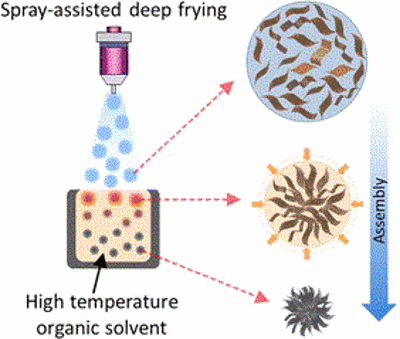Korean material scientists and researchers have published a study detailing how they sprayed graphene into hot solvent and formed pom-pom-like particles suitable for electrodes. 
The articles was printed under the title, “Spray-Assisted Deep-Frying Process for the In Situ Spherical Assembly of Graphene for Energy-Storage Devices,” in Chemistry of Materials .
Actually making graphene foams and aerogels is nothing new. Several groups prior to this one have tried similar methods out before, but results have been unsuitable for electrodes because of bulk and irregularity, as well as the carbon material’s low density.
According to this study’s co-author, Sang-Hoon Park, Department of Materials Science and Engineering, Yonsei University, these other groups made less bulky graphene nanospheres and microspheres using 3D templates and techniques like chemical vapor deposition and freeze-drying. But where these groups tried to make spheres, Park’s group went with a pom-pom-like structure that placed the nanosheets in the center so that it was radiating from the middle.

Park explained that this particular arrangement increased the exposed surface area of the graphene and created open nanochannels which, in turn, enhanced charge transfer.
In terms of the actual practice behind creating these graphene pom-poms, the group simply sprayed the self-assembling graphene oxide droplets into high-temperature organic solvent (as though they were deep frying the material). They found the methodology to not only be consistent but also a remarkably easy, versatile approach to making the electrode materials for batteries and supercapacitors, and believe that this could lead to devices with improved energy and power densities.
Speaking to the broader implications of their discovery, the ability to scale this method up for industrial applications might lead to better batteries in mobile devices; it could also alter the general public’s opinion about batteries in that this source of power would no longer be seen as the weak link in high-level technology.
Advertisement
Learn more about Electronic Products Magazine





